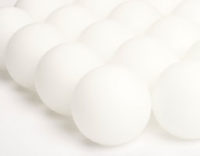New Pretreatment Systems, Primers and Coatings Meet the Challenges of Modern Appliances
Many appliance manufacturers - particularly those that rely on coil coatings - have had to change their finishing practices over the past year to meet new regulatory and design challenges. Fortunately, suppliers have been working behind the scenes to develop innovative pretreatment systems, primers and coatings that can keep manufacturers in compliance with environmental regulations while giving them a competitive edge.

The RoHS Directive implemented by the European Union, along with an expanded use of stainless steel and new design trends, have had a significant impact on the appliance market over the past year. Many appliance manufacturers - particularly those that rely on coil coatings - have had to change their finishing practices to meet these new challenges. Fortunately, suppliers have been working behind the scenes to develop innovative pretreatment systems, primers and coatings that can keep manufacturers in compliance with environmental regulations while giving them a competitive edge.
Many material suppliers began developing new RoHS-compliant products well before the new standards went into effect. For example, PPG Industries, Inc., a coatings supplier, and Henkel, a pretreatment system supplier, began running trials for RoHS approval in January 2006. By July 2006, a paint and pretreatment system developed by the two companies had met the RoHS requirements. PPG developed chrome-free urethane primers, which, when applied over Henkel’s zinc phosphate/chrome-free rinse, met both the new directive and the existing corrosion specifications set up by the major appliance manufacturers. It is important to note that the appliance manufacturers’ specifications did not have to be relaxed to meet the RoHS Directive.
Four colors of chrome-free urethane primers - off-white, gray, black and clean white - were developed to meet the requirements of the market and complement the various topcoats used on appliances. The primer colors need to match the topcoat so that if the appliance is scratched, the color of the primer does not stand out. Black primers are used under black topcoats, off-white primers under white and bisque topcoats, gray primers are used under some metallics, and bright white primers are used under topcoats with incomplete hiding that need to look as bright as possible, such as topcoats containing mica or aluminum flake.

Another trend for stainless appliances is the conversion from 304 stainless to 430 stainless, which costs less than 304 stainless and also allows magnets to stick. A tinted version of the anti-fingerprint clear can be used to make the 430 stainless finish look like the 304 stainless. Other substrates that are increasingly being used are brushed hot dip galvanized (HDG) steel and brushed aluminum; using a tinted clear coating on these substrates provides the look of stainless at lower cost.

Most control panels are made from prepainted aluminum coils. Lettering is screen-printed, accent colors are added to the metal, and then the control panel is formed. The trend for control panels is for increasingly deeper draws, which sometimes require special coating systems that allow the part to be formed without cracking.
For more information about the coatings mentioned in this article, call Scott Moffatt at 724.274.3886. PPG’s website is at www.ppg.com, and Henkel’s website is at www.henkel.com.

The RoHS Directive implemented by the European Union, along with an expanded use of stainless steel and new design trends, have had a significant impact on the appliance market over the past year. Many appliance manufacturers - particularly those that rely on coil coatings - have had to change their finishing practices to meet these new challenges. Fortunately, suppliers have been working behind the scenes to develop innovative pretreatment systems, primers and coatings that can keep manufacturers in compliance with environmental regulations while giving them a competitive edge.
New Options for RoHS Compliance
The RoHS Directive, which went into effect on July 1, 2006, stands for “the restriction of the use of certain hazardous substances in electrical and electronic equipment.” The directive bans any electrical or electronic equipment containing more than the maximum set levels of lead, cadmium, mercury, hexavalent chromium, polybrominated biphenyl (PBB) and polybrominated diphenyl ether (PBDE) from being placed on EU market. In the past, coil primers used for appliance applications often contained chromate pigments, such as strontium chromate.Many material suppliers began developing new RoHS-compliant products well before the new standards went into effect. For example, PPG Industries, Inc., a coatings supplier, and Henkel, a pretreatment system supplier, began running trials for RoHS approval in January 2006. By July 2006, a paint and pretreatment system developed by the two companies had met the RoHS requirements. PPG developed chrome-free urethane primers, which, when applied over Henkel’s zinc phosphate/chrome-free rinse, met both the new directive and the existing corrosion specifications set up by the major appliance manufacturers. It is important to note that the appliance manufacturers’ specifications did not have to be relaxed to meet the RoHS Directive.
Four colors of chrome-free urethane primers - off-white, gray, black and clean white - were developed to meet the requirements of the market and complement the various topcoats used on appliances. The primer colors need to match the topcoat so that if the appliance is scratched, the color of the primer does not stand out. Black primers are used under black topcoats, off-white primers under white and bisque topcoats, gray primers are used under some metallics, and bright white primers are used under topcoats with incomplete hiding that need to look as bright as possible, such as topcoats containing mica or aluminum flake.

New coatings for stainless steel resist fingerprints.
New Solutions for Stainless Steel
As stainless steel appliances have become more popular with consumers, the need for fingerprint resistance has increased. New clear coatings can be applied over the stainless steel at low film thicknesses to maintain the beauty of the steel while preventing unsightly fingerprints.Another trend for stainless appliances is the conversion from 304 stainless to 430 stainless, which costs less than 304 stainless and also allows magnets to stick. A tinted version of the anti-fingerprint clear can be used to make the 430 stainless finish look like the 304 stainless. Other substrates that are increasingly being used are brushed hot dip galvanized (HDG) steel and brushed aluminum; using a tinted clear coating on these substrates provides the look of stainless at lower cost.

The control panel shown above was made from a Novelis Long Line Brushed aluminum substrate and finished with PPG’s mica-containing Gold Novel Clear.
Special Coatings for Control Panels
The major end products for the appliance market are refrigerators, freezers, washers, dryers, ranges and dishwashers. Control panels are required to make these appliances functional, and these panels also must have a high-quality finish.Most control panels are made from prepainted aluminum coils. Lettering is screen-printed, accent colors are added to the metal, and then the control panel is formed. The trend for control panels is for increasingly deeper draws, which sometimes require special coating systems that allow the part to be formed without cracking.
Continued Innovation
The challenges faced by today’s appliance industry are not likely to ease up any time soon. However, with each new challenge comes the opportunity to advance technology and create cutting-edge solutions. Ongoing efforts in research and development will provide the appliance industry with additional finishing innovations in the future.For more information about the coatings mentioned in this article, call Scott Moffatt at 724.274.3886. PPG’s website is at www.ppg.com, and Henkel’s website is at www.henkel.com.
Looking for a reprint of this article?
From high-res PDFs to custom plaques, order your copy today!








